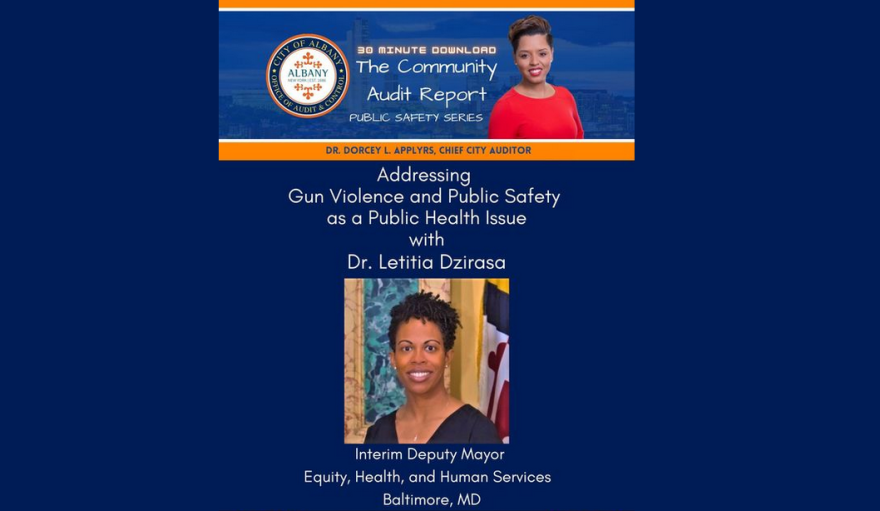Albany City Auditor Dorcey Applyrs hosted an online conversation this week with Baltimore's deputy mayor to share and compare the cities’ experiences with gun violence.
Applyrs has kicked the profile of Chief City Auditor up several notches since Mayor Kathy Sheehan appointed her to serve the remainder of Sue Rizzo's term after Rizzo was elected Albany County Comptroller. Applyrs initiated several projects and programs along with the "30 Minute Download: Community Audit Report," a video series where Applyrs interviews city leaders.
In the latest episode Applyrs welcomed the Baltimore’s Interim Deputy Mayor of Equity, Health and Human Services, Dr. Letitia Dzirasa. The two compared notes regarding Baltimore’s approach to public safety and what lessons Dzirasa could share with Albany.
Dzirasa says Baltimore's population of approximately 600,000 dwarfs Albany's roughly 100,000 resident count.
“When you think about the age spread, about 20% of those residents are under the age of 18," Dzirasa said. "So a decent amount of youth and young people, the average household income is about $55,000, and the poverty rates about 23%. But then when you look at those under 18, it actually creeps up to about 28%. It is a predominantly minority city, about 60% of our population identifies as Black or African American, about 27% identify as white with non-Hispanic origins. We have about a 5 to 6% Hispanic population. And then the rest is either two or more races, or Asian, Pacific Islanders.”
Applyrs says there are "lots of similarities" in demographics for the two cities. According to U.S. Census figures, 50% of Albany residents identify as white with non-Hispanic origins with 28% identifying as Black or African American. Just 16% of Albany’s populace is under age 18 and the average household income is around $52,500.
Here's Applyrs: “And as you all are experiencing in Baltimore, as we are experiencing here in Albany, and urban cities across this country, there has been an uptick in gun violence. Can you please share with us what the gun violence statistics look like for Baltimore?"
“Baltimore, unfortunately has long been associated with, with a really one of the highest murder per capita rates in the country," said Dzirasa. "And unfortunately, as you mentioned, like many parts of the rest of the country, we're seeing this surge, particularly in youth violence, and I know we're going to dig into that a little bit more deeply. But when we kind of do a side to side comparison of where we were in 2022, like the first six, seven months of the year to where we are now, we actually saw a slight decline in homicides. So typically, Baltimore finishes the end of the year, above 300 homicides. Around this time last year, we were sitting at 199 homicides. We're currently sitting around 155 homicides. And then same thing and looking at non-fatal shootings. We were a little over 400 non-fatal shootings around this time last year, and we're at 373 non fatal shootings this year.”
According to the Albany Police Department, the city has seen 13 homicides and 42 people shot so far this year, compared with nine homicides and 46 people shot in 2022.
Applyrs noted that individuals between ages 18 and 24 are most likely to be involved in local gun violence, while Baltimore's age range trends younger. Democratic Mayor Brendan Scott's Violence Prevention Plan has been credited with tamping down gun violence by engaging with people who are the most likely to be either victims or perpetrators. It strives to address the root causes of violence, somewhat akin to Albany's Law Enforcement Assisted Diversion program that began in 2015. Again, Dzirasa.
“What we saw was really more of a creation of a community violence intervention ecosystem that promoted community outreach, funded community outreach by community based partners, not just a government that supports mediation and intervention early on, through partners like Safe Streets, that supports hospital and school-based violence intervention programs, and also provides victim services support and life coaching,” said Dzirasa.
Dzirasa and Applyrs believe gun violence, public safety and public health are intertwined. Dzirasa points out that in even the most violent acts, there were likely some missed interventions that would have prevented that violence in the first place.
“We know that things like your family's socioeconomic status, their access to safe and affordable housing, their access to food or health care, like really these basic necessities, play a role in you know, whether one is at risk for either perpetrating or falling victim to gun violence," Dzirasa said. "And then, of course, the pediatrician in me also recognizes these adverse childhood experiences that contribute to these poor health outcomes, and contribute to risky behaviors. This could be simple as having a parent with substance use disorder, or a parent that's incarcerated.”
For now, both Albany and Baltimore's public officials, business owners, parents and residents continue to hold community discussions on crime prevention strategies and set policies aimed at deterring gun violence. Meeting with reporters after a series of shootings in late June, Albany Police Chief Eric Hawkins said "we need long-term solutions."
"We can arrest all these people that we want, we can take all these guns off the street. But until we break this cycle, we're going to continuously be here," said Hawkins.






